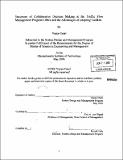Successes of collaborative decision making at the Traffic Flow Management Program Office and the advantages of adopting toolkits
Author(s)
Osuri, Vaynu
DownloadFull printable version (7.731Mb)
Other Contributors
System Design and Management Program.
Advisor
Eric A. von Hippel.
Terms of use
Metadata
Show full item recordAbstract
Manufacturers, product designers and developers of products that have a large and diverse user base are consistently trying to produce products that satisfy as many users as possible. Manufacturers and product developers have found that it is extremely difficult to do so. The closer the manufacturer or developer gets to meeting all user needs, the higher and more prohibitive the cost gets. The Traffic Flow Management (TFM) Program Office, within the Federal Aviation Administration (FAA) has the task the do just that. To its credit the TFM program office has come quite close to achieving this. The goal of this thesis is to identify and document the practices that have made the TFM program office successful and to find ways that can help them achieve even greater end user satisfaction. To do this TFM's complete product development cycle was analyzed. Special attention was given to user interaction and user innovation. (cont.) The research found that the TFM program office does a good job of identifying user requirements, it also does a good job in incorporating user innovations but despite this, they are not able to meet all the user needs. The toolkit model is then used to demonstrate how the TFM program office can overcome some challenges that are inherent to the processes it currently follows.
Description
Thesis (S.M.)--Massachusetts Institute of Technology, System Design and Management Program, 2006. Includes bibliographical references (leaf 68).
Date issued
2006Department
System Design and Management Program.Publisher
Massachusetts Institute of Technology
Keywords
System Design and Management Program.